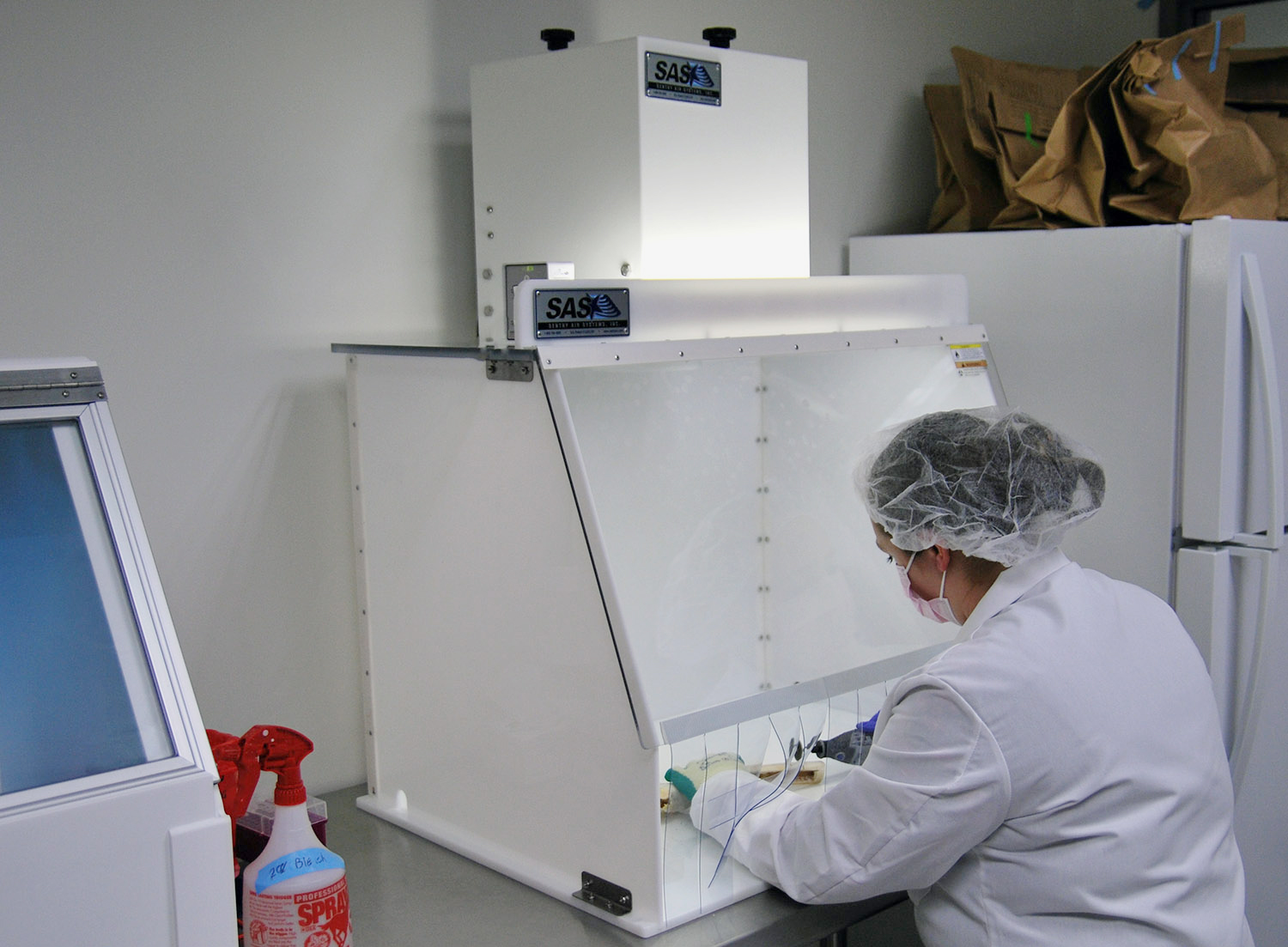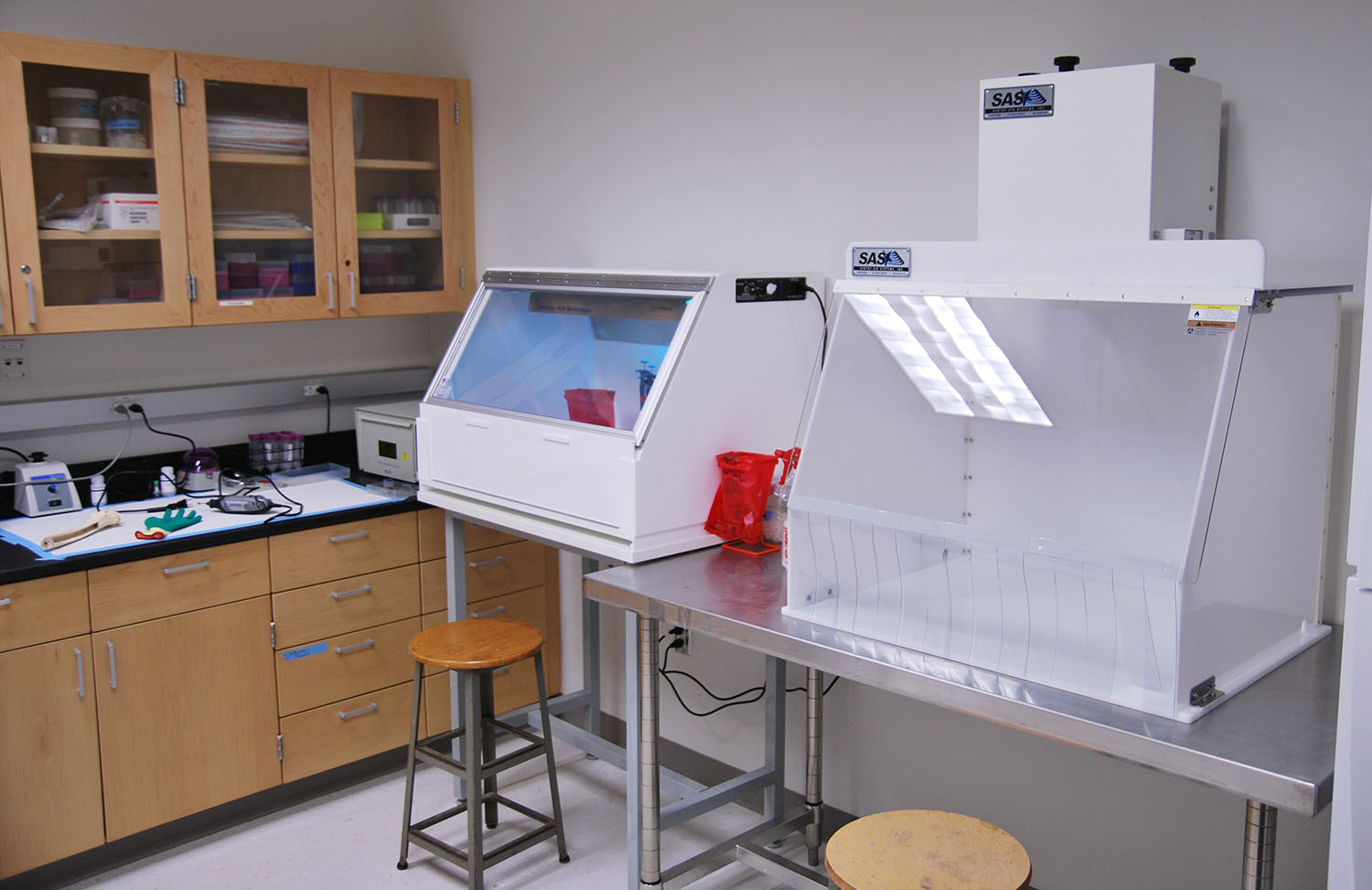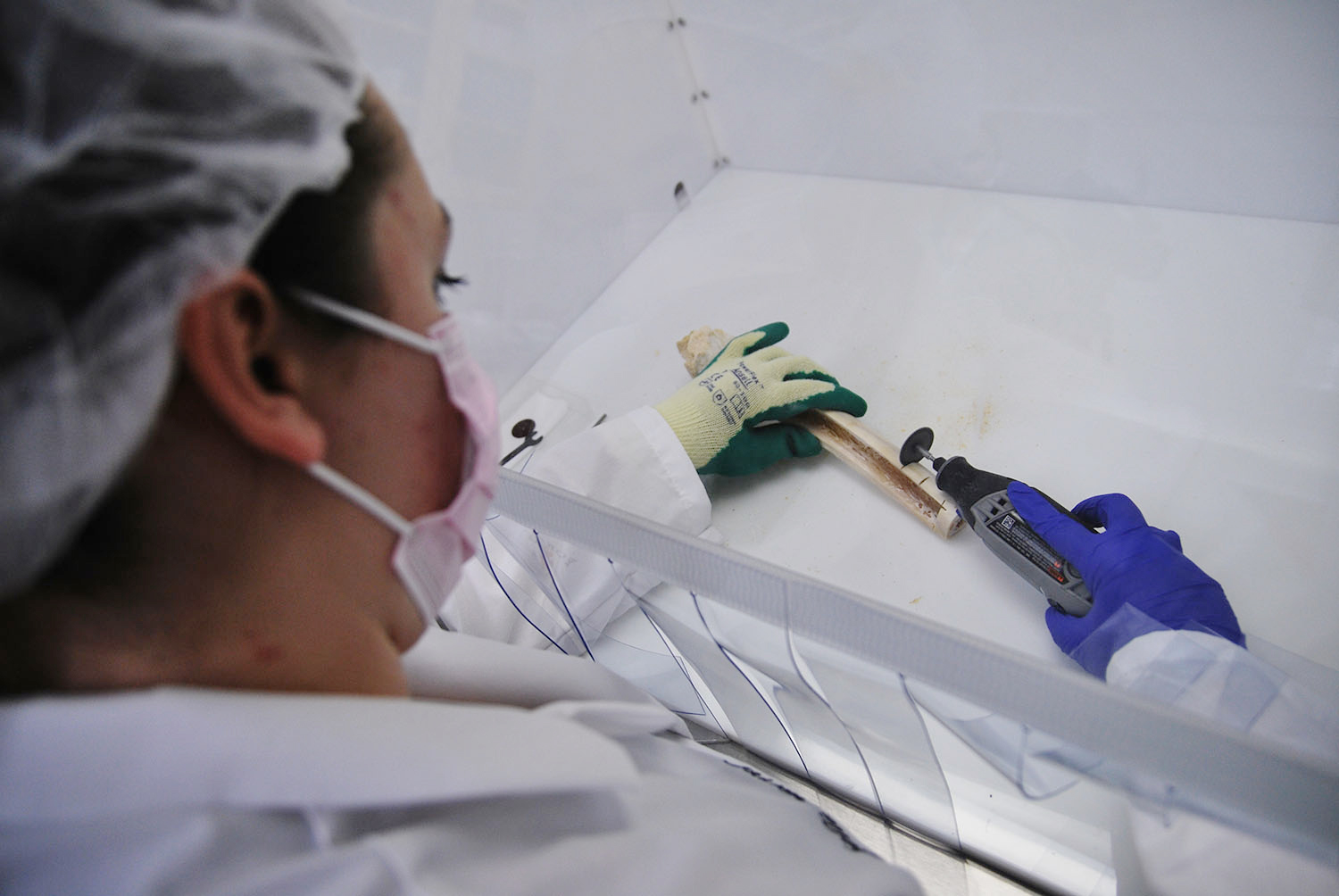
Sam Houston State University Forensic Science students utilize our 30″ Ductless Fume Hood while preparing samples for DNA bone extraction to help protect themselves from chemical fumes and bone dust.
Traditional DNA specimens gathered at crime and trauma scenes include hair, blood, saliva, and other bodily fluids. In most cases these are excellent sources for identifying human remains. Unfortunately, if a body is severely decomposed, exposed to extreme environmental conditions, or only skeletal remains are found, it makes recovering DNA that much more difficult. In these extreme cases, forensic scientists are turning to bones. In an August 2004 article in the Journal of Forensic Sciences entitled “A Simple and Efficient Method for Extraction DNA from Old and Burned Bone”, the authors noted that “compared with the DNA in soft tissue samples, DNA in bone samples is more resistant to the environment’s chemical and physical erosion because of the protection afforded to it by the bone itself” (Ye 2004).
Bone DNA Extraction at the Forensic Science Department of Sam Houston State University
 Students in the Forensic Science Department at Sam Houston State University (SHSU) are learning to extract DNA from bone specimens gathered from the University’s body farm. Dr. Sheree Hughes-Stamm, Clinical Assistant Professor of Forensic Science at SHSU, explains the types of DNA one can extract from bone. “You will be able to extract both nuclear and mitochondrial DNA from bone. However, sometimes the nuclear DNA is too degraded, and/or is in too small amounts to be useful. Therefore mitochondrial DNA is generally used as a last resort for identification.”
Students in the Forensic Science Department at Sam Houston State University (SHSU) are learning to extract DNA from bone specimens gathered from the University’s body farm. Dr. Sheree Hughes-Stamm, Clinical Assistant Professor of Forensic Science at SHSU, explains the types of DNA one can extract from bone. “You will be able to extract both nuclear and mitochondrial DNA from bone. However, sometimes the nuclear DNA is too degraded, and/or is in too small amounts to be useful. Therefore mitochondrial DNA is generally used as a last resort for identification.”
Students use ethanol and bleach to clean the bones in preparation for DNA extraction. Samples are then ground and cut into powder form for use in a PCR machine for DNA retrieval. This process produces chemical fumes and biological particulate posing respiratory hazards for faculty and students. Also, airborne bone dust can lead to cross-contamination of samples which is a big problem for forensic laboratories. Using proper engineering safety controls can help prevent student and faculty exposure to chemical vapors and biological particulate.
Bone DNA Extraction Respiratory Hazards
Bone DNA extraction can expose students and faculty to chemical fumes from ethanol and bleach and biological particulate. OSHA regulates ethanol and bleach fume exposure and the following tables outline both permissible and recommended exposure limits to these hazards as well as known side effects.
Ethyl Alcohol (Ethanol)
| Exposure Limits | Symptoms |
| NIOSH REL 1,000 PPM TWA OSHA PEL 1,000 PPM TWA |
Irritation to eyes, skin, nose Headache Drowsiness Exhaustion Narcosis Cough Liver damage Anemia |
Sodium Hypochlorite (Liquid Bleach)
| Exposure Limits | Symptoms |
| NIOSH REL 0.5 PPM STEL (as Chlorine)OSHA PEL 1,000 PPM TWA |
Irritation to eyes, skin, nose Headache Drowsiness Exhaustion Narcosis Cough Liver damage Anemia |
Ductless Fume Hood for Bone Dust and Chemical Fume Control
Sentry Air Systems (SAS) designs and manufactures a line of Ductless Fume Hoods that help control dust and fumes using high quality filter media. Contaminants generated within the hood’s work area are directed into the filtration chamber using a high-powered fan. The air is processed through 2-3 filters consisting of a pre-filter and 1-2 main filters. The choice of main filters includes HEPA, ASHRAE, ULPA, Activated Carbon, and specialty-blended filter media. For this application, using a combination of HEPA and Activated Carbon filters will help protect against harmful particulate and chemical fumes. After filtration, the ductless fume hood releases the air into the surrounding room, creating a recirculating airflow pattern. This helps save money by removing the requirement for makeup air and installing costly ductwork. It also allows for portability of the fume hood.
How do Ductless Fume Hoods work?
 1. A powerful fan draws in ambient air, and vapors, fumes, and particulate from the process into the filtration chamber.
1. A powerful fan draws in ambient air, and vapors, fumes, and particulate from the process into the filtration chamber.
2. A Pre-Filter processes the air, capturing some of the particles.
3. A Main Filter filters the air. The efficiency depends on the filter choice and application. Two filters can be used for applications that emit both fumes and particulate.
4. The system releases the filtered air back into the room eliminating the need for duct work.
Sentry Air donates a Ductless Fume Hood to Sam Houston State University

Sentry Air’s 30″ Ductless Fume Hood shown on the right at SHSU Forensic Lab
As an alumnus of SHSU, Sentry Air Systems Marketing Director, Patric Sleightholm, and Sales Manager, Omar Ilsever, made an in-kind donation to the Forensic Science Department of our 30” Wide Ductless Fume Hood [SS-330-DCH]. The hood is equipped with HEPA and Carbon filtration to aid in the capture of both bone particulate and chemical vapors. Now, students and faculty can conduct DNA extraction of bone samples within a confined space while protecting their respiratory system. The hood captures contaminants before reaching the operator’s breathing zone and helps prevent cross contamination in the lab.

As shown above, SHSU Masters student Michelle Harrel grinds a sample of bone inside the 30” wide Ductless Containment Hood. Vinyl strip curtains attach along the access area of the hood to increase dust containment.

Another angle of the lab shows the fan/filter unit affixed to the top of the hood. Additionally, a fluorescent light is attached for greater visibility within the hood.
Contact us today to learn about Chemical Fume and Particulate Control in Labs



Call us today at 1.800.799.4609
Related Links
New Blog from 2025 – Donating new DCH2 to SHSU Forensic Science Department
SHSU Department of Forensic Science http://forensics.shsu.edu/
Study To Develop New Forensic Methods For Human DNA Cases http://www.shsu.edu/today@sam/T@S/article/2016/hughes-stamm-nij
References
Ye, J., Ji, A., Parra, E. J., Zheng, X., Jiang, C., Zhao, X., Hu, L., & Tu, Z. (2004). A simple and efficient method for extracting DNA from old and burned bone. Journal of forensic sciences, 49(4), 754–759. Retrieved from: https://pubmed.ncbi.nlm.nih.gov/15317190/

 Made in the USA
Made in the USA